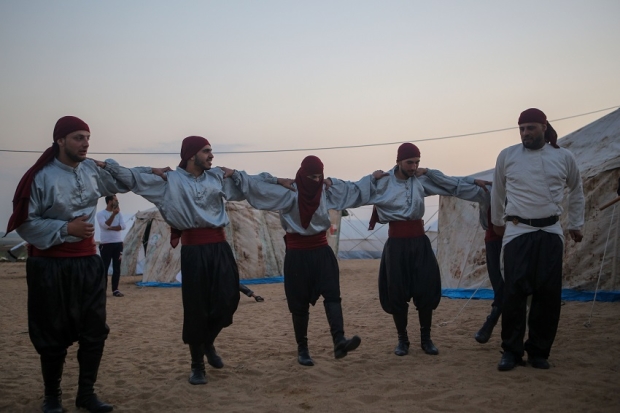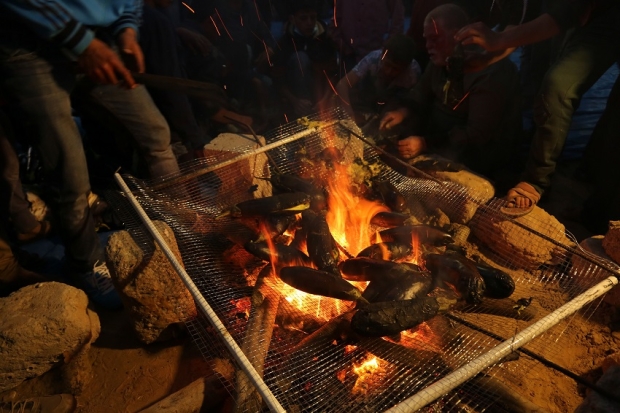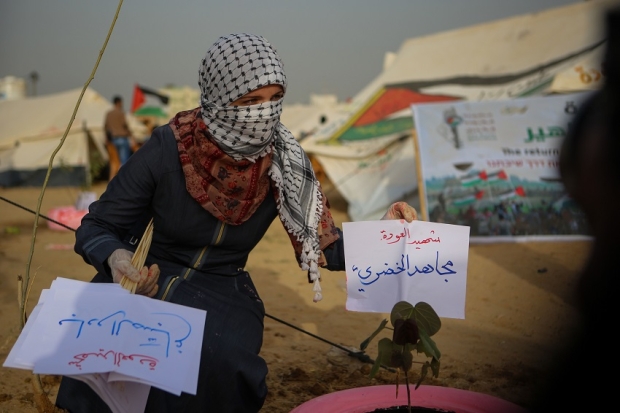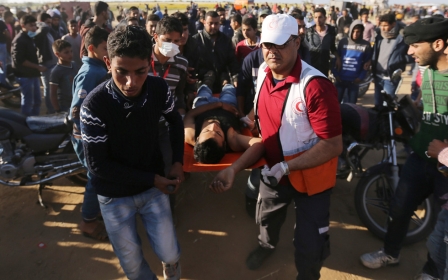Tent city nights: Gaza's dance of resistance unites Palestinians
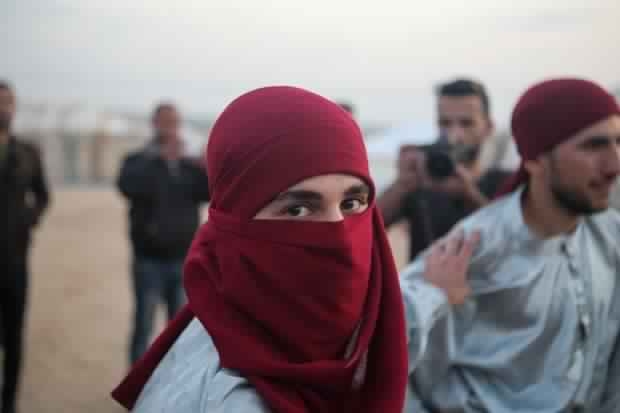
GAZA STRIP – Almost every evening at around 6pm, 32-year-old Iyad Obeid and his dance troupe stomp their feet to the Dabke rhythm and release the occasional "whoop," as demonstrators join in from the neighbouring camps set up around 700 metres away from the eastern border between Gaza and Israel.
“The Dabke entails young people standing in a row, hand in hand, and dancing in unified steps - it represents unity,” Obaid told Middle East Eye.
Obeid's family is originally from Beersheba, which today is a southern Israeli town. According to Obeid, his band Kana’an for Popular Art aims to motivate protesters to preserve and demand their right of return.
I do not want to kill the Israelis like they killed us and stole our lands. I forgive them
- Ahmed Soboh, aged eight, Palestinian refugee
In March, what residents call “tent city” was erected along the border of five governorates of the Gaza Strip, as part of the Grand March Return, a 46-day mass protest that kicked off in Gaza on 30 March on Land day. It is expected to last until 15 May, which marks the 70th anniversary of the Nakba (the catastrophe), when more than 750,000 Palestinians were forcibly displaced from their towns and villages in the Palestinian territories, in the wake of Israel's establishment in May 1948.
Some of the tents display the names of Palestinian villages or cities that were occupied by Israel in 1948 as a testament to the protesters’ struggle to return home.
Protesters say that the long nights spent in the tents bring Palestinians together, reviving their history and heritage.
They shoot us and still call us terrorists
- Bashir Kaskin, protester
As they sing traditional songs like Ya Zareef al-Tool (O’ tall, handsome man), which encourages Palestinians not to leave their home, and ‘Ala Dal’ouna (Let's go help), which talks about the longing for loved ones who left them behind, stories from their past are interwoven when silence mediates the atmosphere.
Bashir Kaskin, 25, is originally from Hamama, a Palestinian town north of Gaza, which was one of some 400 other villages that were destroyed and depopulated in 1948. During an evening in al-Bureij refugee camp in the central Gaza Strip, he prepares Palestinian traditional food on a campfire, enough for friends and neighbouring tents as well.
Kaskin says that the occupants of the tent city do not risk going near the border where Israeli forces stand guard, but they are adamant about staying where they are to demand their right of return.
“We resist in a peaceful way. We are not armed and stand in the face of the Israeli forces’ weapons,” he said. “They shoot us and still call us terrorists.”
According to the Palestinian Ministry of Health, Israeli forces have killed 33 protesters, including three young Palestinians under 18, and have injured over 3,000 others.
The wounded return to protest
The injuries sustained by Ahmed Abu Qamar, a 21-year-old originally from Beersheba, and his friend Nader al-Shalatini, 23, did not prevent them from taking part in the tent’s evening activities.
They were injured on 30 March while protesting unarmed to the east of the village of Jabaliya, in the northern Gaza Strip.
We sing and dance our traditional dances because our ancestors used to perform Dabke as a form of resistance
- Mosa’ab Fodah
While Abu Qamar believes that the Israeli forces deliberately shot them, he says they will continue to protest.
“After I was shot, I spent a week in the hospital but I was eager to return to the protest to tell the occupation that we are persevering regardless of their brutality against us.”
Mosa’ab Fodah, 27, originally from Hamama, speaks of the Palestinian determination to continue their peaceful resistance despite the number of fatalities and injuries.
Fodah protests in the village of Khuzaa, east of Khan Yunis in the southern Gaza strip, and spends his nights in the tents there.
“We are disheartened by every martyr and injured protester who came to resist the Israeli occupation, but this march is our last ray of hope, as life in Gaza has become very stifling. We try to present our history, heritage, and rights in peaceful forms. We sing and dance our traditional dances because our ancestors used to perform Dabke as a form of resistance,” he said.
Israel has imposed a suffocating blockade on the Gaza Strip since 2007 after Hamas took control of Gaza from forces loyal to Palestinian President Mahmoud Abbas, one year after it won legislative elections.
In July 2017, a United Nations report revealed that the life conditions of nearly two million residents - including 1.3 million refugees - are dramatically exacerbating and the Strip has become “unlivable”.
‘We support each other’
In the east of Gaza city, in the al-Shujaiya area, Ahmed Reyad, 40, is lighting a fire in front of his tent to make some coffee. The tent was named after the village Barbara, which was captured by Israel in 1948.
But having passed away in 2011, he never got the chance to realise this dream.
Reyad has fond memories of children gathered around his father, listening to him intently as he told them about their occupied villages and their right of return.
After I was shot, I spent a week in the hospital but I was eager to return to the protest to tell the occupation that we are persevering regardless of their brutality against us
- Ahmed Abu Qamar
Asa’ad often told his son about the family’s piece of land where they grew grapes, figs, olives and other seasonal crops such as tomatoes, cucumbers and eggplants.
He recalls the tough days of May 1948, specifically the night Israelis bombed their land and burned their olives trees. The next day, Reyad’s father left their village and headed to the Jabaliya refugee camp, in the northern Gaza Strip, where the family has been living since.
He wishes his father were alive to witness the Great Return March and the revival of Palestinian heritage in the tent city, where they challenge each other’s knowledge of Palestinian proverbs and tell stories about Barbara village, remembering the delicious different types of grapes it was famous for.
“Every night we gather in the tents, and in the morning I go to work in a carpentry workshop. On Friday, I protest with the youth and we support each other in our struggle for our right of return,” Reyad said.
Reyad’s wife and four children also accompany him to the tent city.
Khalil Awad Allah, 87, reminisced about the nights he spent in his occupied village al-Masmiyya al-Kabira, northeast of Gaza.
This march is our last ray of hope, as life in Gaza has become very stifling
- Mosa’ab Fodah
After performing the sunset Maghrib prayers, in the Salah al-Deen al-Ayoubi mosque near the tents, he recites to the protesters Palestinian folktales and relays stories of Palestinian resistance in the 1940s.
On 15 May 1948, Awad Allah, who was then 17 years old, remembers his tearful father telling him to pack his belongings since they were being forced to leave their home and agricultural land, which is now the occupied village of al-Masmiyya al-Kabira.
Awad Allah recalls how they grew olive trees and apples and raised livestock.
He remembers listening to stories told by different refugees about crimes committed against women and children from different villages, such as the Deir Yassin massacre, which left over 100 civilians dead.
His own family was not without tragedy, as his brother Mosaad was killed at the age of 21 in a confrontation with the Israelis in 1948. He was buried in a mass grave whose whereabouts still remain unknown to the family, ridding them of the chance to even say goodbye.
Games and clowns
Eight-year-old Ahmed Soboh, originally from the village of Dayr Sunayd, dreams of returning there instead of living in Gaza's Al-Shatea refugee camp.
“I do not want to kill the Israelis like they killed us and stole our lands. I forgive them, provided that they leave our land and let us return home,” he said.
The Israeli occupation deliberately steals the Palestinian identity. On the Israeli radio, I hear them speaking about our traditional food as if it is theirs
- Khalid Awad Allah, aged 87
The clowns’ colourful outfits bring a cheerful atmosphere to the camp, as they dance around, blowing whistles and attracting a following of children imitating their every move.
While their parents are careful to keep the children away from the border manned by Israeli forces, they are keen on having them around the camp to educate them on their right of return and their history, as well as understanding the peaceful resistance through which they can fight the Israeli occupation.
Awad Allah wants Palestinian identity to remain a core issue and would like the tent city to continue even after the culmination of the Great Return March on 15 May.
“The Israeli occupation deliberately steals the Palestinian identity. On the Israeli radio, I hear them speaking about our traditional food as if it is theirs. I urge the Palestinian young men and women to preserve the Palestinian heritage in their clothes, history, food, etc. We need to make a point that we struggle to maintain our Palestinian identity,” he said.
Middle East Eye propose une couverture et une analyse indépendantes et incomparables du Moyen-Orient, de l’Afrique du Nord et d’autres régions du monde. Pour en savoir plus sur la reprise de ce contenu et les frais qui s’appliquent, veuillez remplir ce formulaire [en anglais]. Pour en savoir plus sur MEE, cliquez ici [en anglais].


